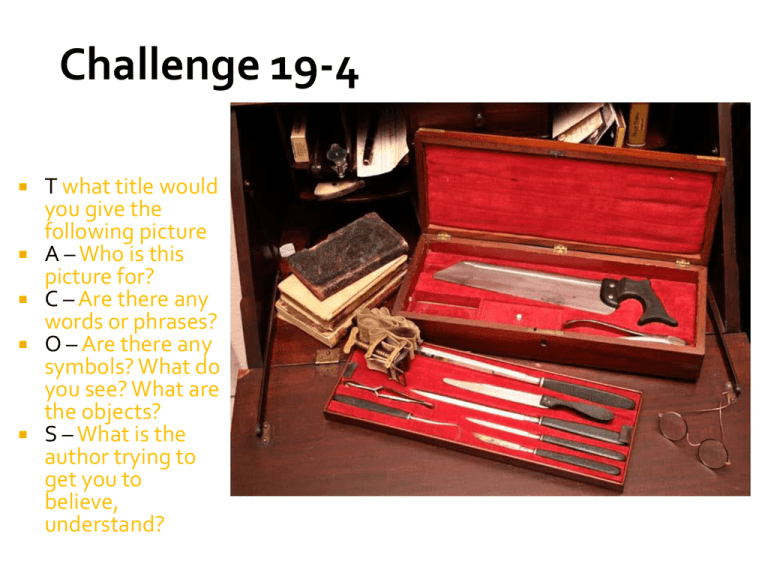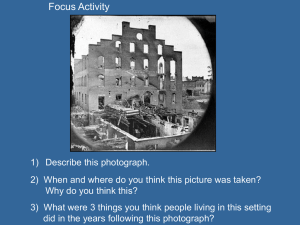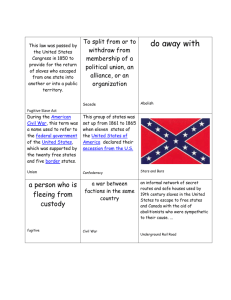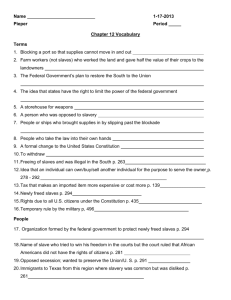Chapter 3 Exploring Texas: 1519-1700
advertisement

Challenge 19-4 T what title would you give the following picture A – Who is this picture for? C – Are there any words or phrases? O – Are there any symbols? What do you see? What are the objects? S – What is the author trying to get you to believe, understand? Slavery was legal in Texas and most of the South – Southerners believed it supported the economy Most Northerners opposed slavery. They believed it was immoral (wrong for one to own another). Eli Whitney’s cotton gin, a machine that removed cotton seeds from the fiber, made cotton very profitable. Created a demand for slaves. Avg. price of slave = $600, if skilled = more than $2000 Most could not afford slaves Slaves regarded as property; could be bought, sold, or rented Some treated slaves reasonably well, others were very cruel (beatings, poor food, etc.) Usually 6-day work week with Sundays off; sunrise to sunset workday Children born of slaves were slaves Families torn apart by slave trade Religion and music were key elements of culture; religion offered comfort and hope; music allowed expression of sorrow & hope for better life Not many rebellions – fear of punishment to selves and others Resistance: 1) most TX runaways fled to Mexico, 2) work slowly, 3) break or damage property Harriet Beecher Stowe wrote this book. It is about a slave named Tom treated cruelly by a brutal slaveholder, and a slave woman named Eliza escaping to freedom on the Underground Railroad. Stowe’s novel, Uncle Tom’s Cabin had an impact on the abolitionist movement leading up to the Civil War. In 1854, this act gave the people of these territories the right to decide if they would allow slavery (popular sovereignty). It was supported by most Southerners and created more division apart from the North on this issue. The idea that states have the right to limit the power of the federal government. Most Southerners (including Texans), favored state’s rights. Southerners believed the federal government went beyond their power in trying to limit the spread of slavery. 1857 Supreme Court case where a slave sued for his freedom on the basis that he lived in a free state. Court ruled that slaves were not citizens, and the case was lost, angering abolitionists. Secede: withdraw from the Union Governor Sam Houston was a Unionist (did not want to secede) Abraham Lincoln was elected U.S. President in 1860, further increasing the South’s desire to split the nation. South Carolina was the 1st to secede. Other states soon followed, including Texas (7th) forming the Confederate States of America. Sam Houston refused to sign an oath to the Confederacy and was removed from office as governor of Texas Union Leader – Ulysses S. Grant Confederate Leader – Robert E. Lee Confederate President – Jefferson Davis 1st battle – Ft. Sumter Costliest battle – Gettysburg 384 major battles (10,500 conflicts) Lasted from April 12, 1861 – April 9, 1865 (Lee surrendered to Grant at the Appomattox Court House) Confederate capital: Richmond, VA U.S. said secession was illegal South said they freely joined & could freely leave Advantage North – outnumbered South 4 to 1 in men of fighting age Advantage North – controlled factories and transportation Advantage South – generals; know the land Both sides believe war will be over in a matter of months Both sides call for volunteers Men of fighting age: (18-45) North 4 million South 1 million Some Texans (Anglo, Black, and Mexican) fought for the Union Union blockade: shortage of supplies for South (South used blockade runners) Relied on Texas farms for corn & wheat to feed Confed. army; also made uniforms Went w/out coffee, sugar, paper, & other items The North had a higher population, greater factory production, more railroad mileage, and more farmland than the South. The South had higher cotton production than the North. Which had more strengths? 70,000 served in Confederacy Most serve in Texas Arkansas, Louisiana Some as far away as Virginia 2,000 serve in Union Volunteers not sufficient Both sides begin conscriptions (draft) Age limits change as war goes on (18-30) becomes (17-45) South (Confederacy) Exempt if own >15 slaves Can hire someone to take place Most live in Northern & Western part of TX The “Great Hanging” Gainesville, TX 1862, 150 unionist arrested for treason 40 hanged Nueces Massacre 1862, 65 neutral Germans try to leave TX 20 die during clash with Confederates near Nueces River 9 executed Surrender at Appomotox Union General Ulysses S. Grant trapped Confederate General Robert E. Lee at Petersburg, Virginia Union General William T. Sherman captured Atlanta, Georgia Grant accepted Lee’s surrender at the Appomtox Court House on April 9, 1865 Battle at Palmito Ranch Some Texas Confederates refused to give up the war On May 12, 1865, Union Colonel Theodore H. Barnett attacked Confederate forces at Palmito Ranch The Confederates counterattacked, forcing Barret to retreat Despite this victory, the Texas Confederates received orders to disband their armies June 19, 1865 Texas slaves finally got word they were free Word was brought by General Gordon Granger of the Union Army Celebrated as a state holiday UNION 110,000 killed in battle (24%) 225,000 die from disease $6 Billion CONFEDERACY 94,000 killed in battle (23%) 164,000 die from disease $2 Billion Deaths in American Wars Civil War 618,000 World War II 405,000 World War I 112,000 Vietnam War 58,000 Korean War 54,000 Mexican War 13,000 Revolution 4,000 Spanish-American War 2,000 War of 1812 2,000 Shot on April 14, 1865 at Ford’s Theater by John Wilkes Booth Died one day later Booth shot and killed April 26 Causes Effects The constitution of 1866 meets President Andrew Johnson’s conditions. Texas is allowed to rejoin the Union. Congress dislikes the fact that former Confederates regained power in the South. Congress puts military government in the South and requires a new state constitution. The constitution of 1869 gives African Americans the right to vote. Texas is admitted back into the Union in March 1870. Texans dislike strong central government. Texans approve a new constitution in 1876, in which they limit the governor’s power. Black codes – laws passed by southern states that severely limited the rights of freedmen How did black codes affect freedmen? Black codes granted some rights. African Americans could marry legally and own some property Black codes kept freedmen from gaining political and economic power. They forbade freedmen to vote, own guns, or serve on juries In some states, African Americans could work only as servants or farm laborers. In others, they had to sign contracts for a year’s work How did Congress react to black codes? Angered by black codes, Republicans charged that Johnson’s lenient Reconstruction plan had encouraged the codes Republicans were also angered by southern white violence against freedmen Economic Changes Cotton, wheat and corn production increased, due to the expansion of the railroad Texans developed more industries, producing textiles, iron, and other goods New Labor System The sharecropper system replaced the system of slave labor after the Civil War Landowners assumed all the housing and production costs in exchange for the sharecropper working the land Sharecroppers gave half the value of their crop to the landowner Cut the governor’s power to appoint officers Limited elected leaders to two-year terms Gave all males, including African Americans, the right to vote Required that voters approve any changes to the constitution Remains the basic law of Texas to this DAY T _what title would you give the following picture A – Who is this political cartoon for? C – Are there any words or phrases? O – Are there any symbols? What do you see? S – What is the author trying to get you to believe? OUT T _what title would you give the following picture A – Who is this political cartoon for? C – Are there any words or phrases? O – Are there any symbols? What do you see? S – What is the author trying to get you to believe? OUT T _what title would you give the following picture A – Who is this political cartoon for? C – Are there any words or phrases? O – Are there any symbols? What do you see? S – What is the author trying to get you to believe? Collection of Civil War Rifles Spencer Repeating Rifle Union Confederate





